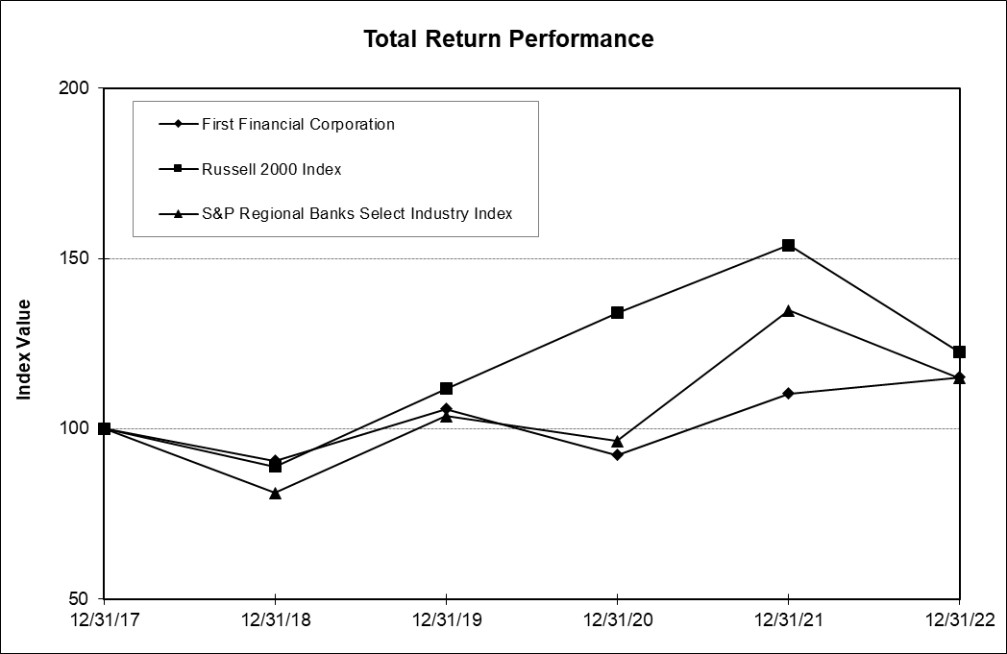NOTES TO CONSOLIDATED FINANCIAL STATEMENTS
1.BUSINESS AND SIGNIFICANT ACCOUNTING POLICIES:
BUSINESS
Organization: The consolidated financial statements of First Financial Corporation and its subsidiaries (the Corporation) include the parent company and its wholly-owned subsidiaries, First Financial Bank, N.A., headquartered in Vigo County, Indiana, and FFB Risk Management Co., Inc., a captive insurance subsidiary headquartered in Las Vegas, Nevada. Inter-company transactions and balances have been eliminated.
First Financial Bank also has two investment subsidiaries, Portfolio Management Specialists A (Specialists A) and Portfolio Management Specialists B (Specialists B), which were established to hold and manage certain assets as part of a strategy to better manage various income streams and provide opportunities for capital creation as needed. Specialists A and Specialists B subsequently entered into a limited partnership agreement, Global Portfolio Limited Partners. Portfolio Management Specialists B also owns First Financial Real Estate, LLC. At December 31, 2022, $1.0 billion of securities and loans were owned by these subsidiaries. Specialists A, Specialists B, Global Portfolio Limited Partners and First Financial Real Estate LLC are included in the consolidated financial statements. First Financial Bank also has wholly-owned subsidiaries JBMM, LLC and Fort Webb LP, LLC.
The Corporation, which is headquartered in Terre Haute, Indiana, offers a wide variety of financial services including commercial, mortgage and consumer lending, lease financing, trust account services and depositor services through its four subsidiaries. The Corporation’s primary source of revenue is derived from loans to customers and investment activities.
The Corporation operates 78 branches in west-central Indiana, east-central Illinois, western Kentucky, and central Tennessee. First Financial Bank is the largest bank in Vigo County. It operates nine full-service banking branches within the county; one in Daviess County, Indiana.; three in Clay County, Indiana; one in Greene County, Indiana; one in Knox County, Indiana; two in Parke County, Indiana; one in Putnam County, Indiana; three in Sullivan County, Indiana; one in Vanderburgh County, Indiana,; three in Vermillion County, Indiana; four in Champaign County, Illinois; one in Clark County, Illinois; two in Coles County, Illinois; two in Crawford County, Illinois; one in Franklin County, Illinois; one in Jasper County, Illinois; two in Jefferson County, Illinois; one in Lawrence County, Illinois; two in Livingston County, Illinois; two in Marion County, Illinois; two in McLean County, Illinois; one in Richland County, Illinois; six in Vermilion County, Illinois; one in Wayne County, Illinois; one in Breckinridge County, Kentucky; two in Calloway County, Kentucky; three in Christian County, Kentucky; two in Fulton County, Kentucky; two in Hancock County, Kentucky; two in Hopkins County, Kentucky; two in Marshall County, Kentucky; one in Todd County, Kentucky; one in Trigg County, Kentucky; two in Warren County, Kentucky; three in Cheatham County, Tennessee; one in Houston County, Tennessee; and three in Montgomery County, Tennessee. There are five loan production offices, one in Hamilton County, Indiana; one in Monroe County, Indiana; one in Vanderburgh County, Indiana; one in Rutherford County, Tennessee; and one in Williamson County, Tennessee. The bank also has a main office in downtown Terre Haute and an operations center/office building in southern Terre Haute.
Regulatory Agencies: First Financial Corporation is a multi-bank holding company and as such is regulated by various banking agencies. The holding company is regulated by the Seventh District of the Federal Reserve System. The national bank subsidiary is regulated by the Office of the Comptroller of the Currency. The state bank subsidiary is jointly regulated by the state banking organization and the Federal Deposit Insurance Corporation. FFB Risk Management Company is regulated by the State of Nevada Division of Insurance.
SIGNIFICANT ACCOUNTING POLICIES
Use of Estimates: To prepare financial statements in conformity with U.S. generally accepted accounting principles, management makes estimates and assumptions based on available information. These estimates and assumptions affect the amounts reported in the financial statements and disclosures provided, and actual results could differ.
Cash Flows: Cash and cash equivalents include cash and demand deposits with other financial institutions. Cash flows are reported for customer loan and deposit transactions and short-term borrowings. Non-cash transactions include loans transferred to other real estate of $570 thousand, $43 thousand and $567 thousand for the years ended December 31, 2022, 2021 and 2020 respectively.
